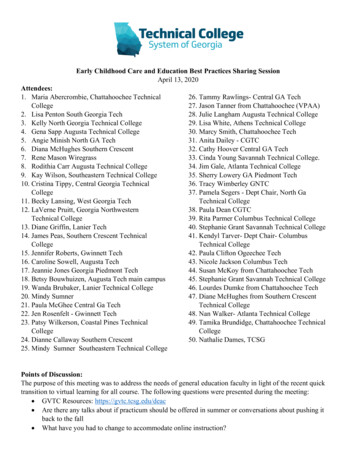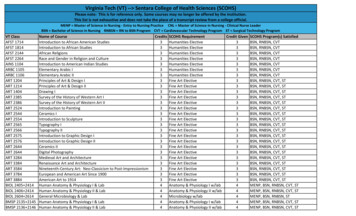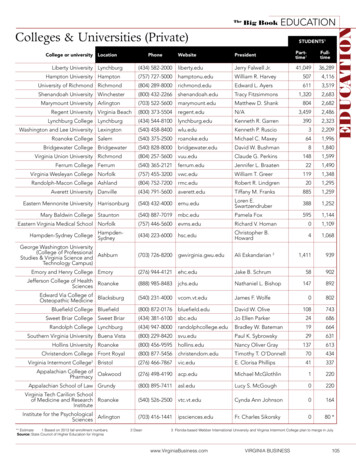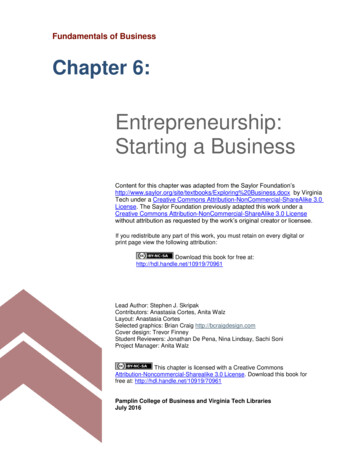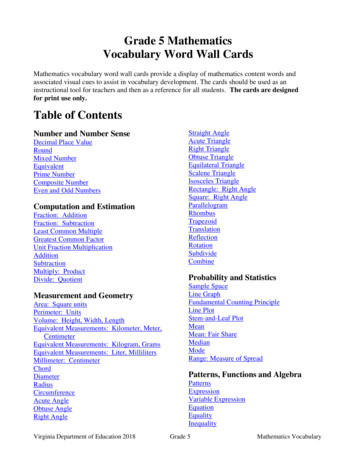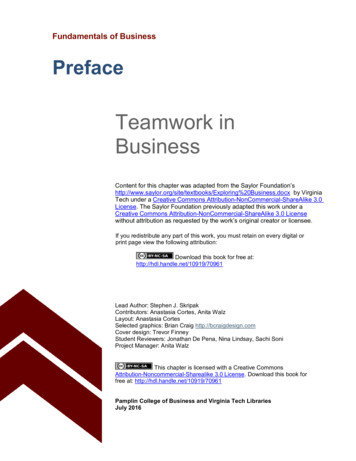
Transcription
Fundamentals of BusinessPrefaceTeamwork inBusinessContent for this chapter was adapted from the Saylor /Exploring%20Business.docx by VirginiaTech under a Creative Commons Attribution-NonCommercial-ShareAlike 3.0License. The Saylor Foundation previously adapted this work under aCreative Commons Attribution-NonCommercial-ShareAlike 3.0 Licensewithout attribution as requested by the work’s original creator or licensee.If you redistribute any part of this work, you must retain on every digital orprint page view the following attribution:Download this book for free at:http://hdl.handle.net/10919/70961Lead Author: Stephen J. SkripakContributors: Anastasia Cortes, Anita WalzLayout: Anastasia CortesSelected graphics: Brian Craig http://bcraigdesign.comCover design: Trevor FinneyStudent Reviewers: Jonathan De Pena, Nina Lindsay, Sachi SoniProject Manager: Anita WalzThis chapter is licensed with a Creative CommonsAttribution-Noncommercial-Sharealike 3.0 License. Download this book forfree at: http://hdl.handle.net/10919/70961Pamplin College of Business and Virginia Tech LibrariesJuly 2016
[This page intentionally left blank]
PrefaceTeamwork in BusinessLearning Objectives1) Define a team and describe its key characteristics.2) Explain why organizations use teams, and describe differenttypes of teams.3) Explain why teams may be effective or ineffective.4) Identify factors that contribute to team cohesiveness.5) Understand the importance of learning to participate in teambased activities.6) Identify the skills needed by team members and the rolesthat members of a team might play.7) Learn how to survive team projects in college (and actuallyenjoy yourself).8) Explain the skills and behaviors that foster effective teamleadership.PrefaceDownload this book for free at:http://hdl.handle.net/10919/709611
The Team with the RAZR’s EdgeThe publicly traded company MotorolaMobility was created when Motorola spun off itsFigure P.1: The Droid RAZRMobile Devices division, creating a new entity. Thenewly-formed company’s executive team was underintense pressure to come out with a smartphonethat could grab substantial market share fromApple’s iPhone 4S and Samsung’s Galaxy Nexus.To do this, the team oversaw the design of anAndroid version of the Motorola RAZR, which wasonce the best-selling phone in the world. The hopeof the executive team was that past customers wholoved the RAZR would love the new ultra-thinsmartphone—the Droid RAZR. The Droid RAZRwas designed by a team, as are other Motorolaproducts. To understand the team approach atMotorola, let’s review the process used to design the RAZR.By winter 2003, the company that for years had run ringtones around the competitionhad been bumped from the top spot in worldwide sales.1 Motorola found itself stuck in thenumber-three slot. Their sales had declined because consumers were less than enthusiasticabout the uninspired style of Motorola phones, and for many people, style is just as importantin picking a cell phone as features. As a reviewer for one industry publication put it, “We justwant to see the look on people’s faces when we slide [our phones] out of our pockets to take acall.”Yet there was a glimmer of hope at Motorola. Despite its recent lapse in cell phonefashion sense, Motorola still maintained a concept-phone unit—a group responsible fordesigning futuristic new product features such as speech-recognition capability, flexibletouchscreens, and touch-sensitive body covers. In every concept-phone unit, developers2Download this book for free at:http://hdl.handle.net/10919/70961Preface
engage in an ongoing struggle to balance the two often-opposing demands of cell phonedesign: building the smallest possible phone with the largest possible screen. The previousyear, Motorola had unveiled the rough model of an ultra-trim phone—at 10 millimeters, abouthalf the width of the average flip-top or “clamshell” design. It was on this concept that Motoroladecided to stake the revival of its reputation as a cell phone maker who knew how to packagefunctionality with a wow factor.The next step in developing a concept phone is actually building it. Teamwork becomescritical at this point. The process requires some diversity in expertise. An electronics engineer,for example, knows how to apply energy to transmit information through a system but not howto apply physics to the design and manufacture of the system; that’s the specialty of amechanical engineer. Engineers aren’t designers—the specialists who know how to enhancethe marketability of a product through its aesthetic value. Designers bring their own uniquevalue to the team.In addition, when you set out to build any kind of innovative high-tech product, you needto become a master of trade-offs—in Motorola’s case, compromises resulted from thedemands of state-of-the-art functionality on one hand and fashionable design on the other.Negotiating trade-offs is a team process: it takes at least two people to resolve designdisputes.The responsibility for assembling and managing the Motorola “thin-clam” team fell toveteran electronic engineer Roger Jellicoe. His mission: create the world’s thinnest phone, doit in one year, and try to keep it a secret. Before the project was completed, the team hadgrown to more than twenty members, and with increased creative input and enthusiasm cameincreased confidence and clout. Jellicoe had been warned by company specialists in suchmatters that no phone wider than 49 millimeters could be held comfortably in the human hand.When the team had finally arrived at a satisfactory design that couldn’t work at less than 53millimeters, they ignored the “49 millimeters warning,” built a model, passed it around, andcame to a consensus: as one team member put it, “People could hold it in their hands and say,‘Yeah, it doesn’t feel like a brick.’” Four millimeters, they decided, was an acceptable trade-off,and the new phone went to market at 53 millimeters. While small by today’s standards, at thetime, 53 millimeters was a gamble.PrefaceDownload this book for free at:http://hdl.handle.net/10919/709613
Team members liked to call the design process the “dance.” Sometimes it flowedsmoothly and sometimes people stepped on one another’s toes, but for the most part, theteam moved in lockstep toward its goal. After a series of trade-offs about what to call the finalproduct (suggestions ranged from Razor Clam to V3), Motorola’s new RAZR was introduced inJuly 2004. Recall that the product was originally conceived as a high-tech toy—something torestore the luster to Motorola’s tarnished image. It wasn’t supposed to set sales records, andsales in the fourth quarter of 2004, thoughpromising, were in fact fairly modest. Back inSeptember, however, a new executive namedFigure P.2: The original best-sellingMotorola RAZRRon Garriques had taken over Motorola’s cellphone division; one of his first decisions was toraise the bar for RAZR. Disregarding a 2005budget that called for sales of two million units,Garriques pushed expected sales for the RAZRup to twenty million. The RAZR topped that target,shipped ten million in the first quarter of 2006, andhit the fifty-million mark at midyear. Talking on aRAZR, declared hip-hop star Sean “P. Diddy”Combs, “is like driving a Mercedes versus aregular ol’ ride.”2Jellicoe and his team were invited to attend an event hosted by top executives,receiving a standing ovation, along with a load of stock options. One of the reasons for theRAZR’s success, said Jellicoe, was that “It took the world by surprise. Very few Motorolaproducts do that.” For a while, the new RAZR was the best-selling phone in the world.The Team and the OrganizationWhat Is a Team? How Does Teamwork Work?A team (or a work team) is a group of people with complementary skills who worktogether to achieve a specific goal.3 In the case of Motorola’s RAZR team, the specific goalwas to develop (and ultimately bring to market) an ultrathin cell phone that would help restore4Download this book for free at:http://hdl.handle.net/10919/70961Preface
the company’s reputation. The team achieved its goal by integrating specialized butcomplementary skills in engineering and design and by making the most of its authority tomake its own decisions and manage its own operations.Teams versus GroupsAs Bonnie Edelstein, a consultant in organizational development suggests, “A group is abunch of people in an elevator. A team is also a bunch of people in an elevator, but theelevator is broken.”4 This distinction may be a little oversimplified, but as our tale of teamworkat Motorola reminds us, a team is clearly something more than a mere group of individuals. Inparticular, members of a group—or, more accurately, a working group—go about their jobsindependently and meet primarily to work towards a shared objective. A group of departmentstore managers, for example, might meet monthly to discuss their progress in cutting plantcosts. However, each manager is focused on the goals of his or her department because eachis held accountable for meeting those goals.Some Key Characteristics of TeamsTo put teams in perspective, let’s identify five key characteristics. Teams:51) Share accountability for achieving specific common goals2) Function interdependently3) Require stability4) Hold authority and decision-making power5) Operate in a social contextWhy Organizations Build TeamsWhy do major organizations now rely so much on teams to improve operations?Executives at Xerox have reported that team-based operations are 30 percent more productivethan conventional operations. General Mills says that factories organized around teamactivities are 40 percent more productive than traditionally organized factories. FedEx saysthat teams reduced service errors (lost packages, incorrect bills) by 13 percent in the firstyear.6PrefaceDownload this book for free at:http://hdl.handle.net/10919/709615
Today it seems obvious that teams can address a variety of challenges in the world ofcorporate activity. Before we go any further, however, we should remind ourselves that thedata we’ve just cited aren’t necessarily definitive. For one thing, they may not be objective—companies are more likely to report successes than failures. As a matter of fact, teams don’talways work. According to one study, team-based projects fail 50 to 70 percent of the time.7The Effect of Teams on PerformanceResearch shows that companies build and support teams because of their effect onoverall workplace performance, both organizational and individual. If we examine the impact ofteam-based operations according to a wide range of relevant criteria, we find that overallorganizational performance generally improves. Figure P.3 lists several areas in which we cananalyze workplace performance and indicates the percentage of companies that have reportedimprovements in each area.Figure P.3: Performance improvements due to team-based operationsArea of PerformanceFirms Reporting ImprovementProduct and service quality70%Customer service67%Worker satisfaction66%Quality of work ity45%Absenteeism/turnover23%Source: Adapted from Edward E. Lawler, S. A. Mohman, and G. E. Ledford(1992). Creating High Performance Organizations: Practices and Results ofEmployee Involvement and Total Quality in Fortune 1000 Companies. SanFrancisco: Wiley.6Download this book for free at:http://hdl.handle.net/10919/70961Preface
Types of TeamsTeams, then, can improve company and individual performance in a number of areas.Not all teams, however, are formed to achieve the same goals or charged with the sameresponsibilities. Nor are they organized in the same way. Some, for instance, are moreautonomous than others—less accountable to those higher up in the organization. Somedepend on a team leader who’s responsible for defining the team’s goals and making sure thatits activities are performed effectively. Others are more or less self- governing: though a leaderlays out overall goals and strategies, the team itself chooses and manages the methods bywhich it pursues its goals and implements its strategies.8 Teams also vary according to theirmembership. Let’s look at several categories of teams.Manager-Led TeamsAs its name implies, in the manager-led team themanager is the team leader and is in charge of setting teamgoals, assigning tasks, and monitoring the team’sFigure P.4: Football coachesFrank Beamer and JimboFisher after a game.performance. The individual team members have relativelylittle autonomy. For example, the key employees of aprofessional football team (a manager-led team) are highlytrained (and highly paid) athletes, but their activities on thefield are tightly controlled by a head coach. As team manager,the coach is responsible both for developing the strategies bywhich the team pursues its goal of winning games and for theoutcome of each game and season. He’s also solelyresponsible for interacting with managers above him in theorganization. The players are responsible mainly for executingplays.9Self-Managing TeamsSelf-managing teams (also known as self-directed teams) have considerableautonomy. They are usually small and often absorb activities that were once performed bytraditional supervisors. A manager or team leader may determine overall goals, but themembers of the self-managing team control the activities needed to achieve those goals.PrefaceDownload this book for free at:http://hdl.handle.net/10919/709617
Self-managing teams are the organizational hallmark of Whole Foods Market, thelargest natural-foods grocer in the United States. Each store is run by ten departmental teams,and virtually every store employee is a member of a team. Each team has a designated leaderand its own performance targets. (Team leaders also belong to a store team, and store-teamleaders belong to a regional team.) To do its job, every team has access to the kind ofinformation—including sales and even salary figures—that most companies reserve fortraditional managers.10Not every self-managed team enjoys the same degree of autonomy. Companies varywidely in choosing which tasks teams are allowed to manage and which ones are best left toupper-level management only. As you can see in Figure P.5 for example, self-managing teamsare often allowed to schedule assignments, but they are rarely allowed to fire coworkers.Figure P.5: What teams do (and don’t) manage themselves8Download this book for free at:http://hdl.handle.net/10919/70961Preface
Cross-Functional TeamsMany companies use cross-functional teams—teams that, as the name suggests, cutacross an organization’s functional areas (operations, marketing, finance, and so on). A crossfunctional team is designed to take advantage of the special expertise of members drawn fromdifferent functional areas of the company. When the Internal Revenue Service, for example,wanted to study the effects on employees of a major change in information systems, it createda cross-functional team composed of people from a wide range of departments. The final studyreflected expertise in such areas as job analysis, training, change management, industrialpsychology, and ergonomics.11Cross-functional teams figure prominently in the product-development process at Nike,where they take advantage of expertise from both inside and outside the company.Typically, team members include not only product designers, marketing specialists, andaccountants but also sports-research experts, coaches, athletes, and even consumers.Likewise, Motorola’s RAZR team was a cross-functional team; responsibility for developing thenew product wasn’t passed along from the design team to the engineering team but rather wasentrusted to a special team composed of both designers and engineers.Committees and task forces, both of which are dedicated to specific issues or tasks, areoften cross-functional teams. Problem-solving teams, which are created to study such issuesas improving quality or reducing waste, may be either intradepartmental or cross- functional.12Virtual TeamsTechnology now makes it possible for teams to function not only across organizationalboundaries like functional areas but also across time and space. Technologies such asvideoconferencing allow people to interact simultaneously and in real time, offering a numberof advantages in conducting the business of a virtual team.13 Members can participate fromany location or at any time of day, and teams can “meet” for as long as it takes to achieve agoal or solve a problem—a few days, weeks, or months.Team size does not seem to be an obstacle when it comes to virtual-team meetings; inbuilding the F-35 Strike Fighter, U.S. defense contractor Lockheed Martin staked the 225billion project on a virtual product-team of unprecedented global dimension, drawing onPrefaceDownload this book for free at:http://hdl.handle.net/10919/709619
designers and engineers from the ranks of eight international partners from Canada, theUnited Kingdom, Norway, and Turkey.14Why Teamwork WorksNow that we know a little bit about how teams work, we need to ask ourselves why theywork. Not surprisingly, this is a fairly complex issue. In this section, we’ll explore why teamsare often effective and when they ineffective.Factors in Effective TeamworkFirst, let’s begin by identifying several factors that contribute to effective teamwork.Teams are most effective when the following factors are met: Members depend on each other. When team members rely on each other to getthe job done, team productivity and efficiency tend to be high. Members trust one another. Members work better together than individually. When team members performbetter as a group than alone, collective performance exceeds individualperformance. Members become boosters. When each member is encouraged by other teammembers to do his or her best, collective results improve. Team members enjoy being on the team. Leadership rotates.Some of these factors may seem intuitive. Because such issues are rarely clear-cut, weneed to examine the issue of group effectiveness from another perspective—one thatconsiders the effects of factors that aren’t quite so straightforward.Group CohesivenessThe idea of group cohesiveness refers to the attractiveness of a team to its members.If a group is high in cohesiveness, membership is quite satisfying to its members. If it’s low incohesiveness, members are unhappy with it and may try to leave it.1510Download this book for free at:http://hdl.handle.net/10919/70961Preface
What Makes a Team Cohesive?Numerous factors may contribute to team cohesiveness, but in this section, we’ll focuson five of the most important:1) Size. The bigger the team, the less satisfied members tend to be. When teamsget too large, members find it harder to interact closely with other members; afew members tend to dominate team activities, and conflict becomes more likely.2) Similarity. People usually get along better with people like themselves, andteams are generally more cohesive when members perceive fellow members aspeople who share their own attitudes and experience.3) Success. When teams are successful, members are satisfied, and other peopleare more likely to be attracted to their teams.4) Exclusiveness. The harder it is to get into a group, the happier the people whoare already in it. Team status also increases members’ satisfaction.5) Competition. Membership is valued more highly when there is motivation toachieve common goals and outperform other teams.Maintaining team focus on broad organizational goals is crucial. If members get toowrapped up in immediate team goals, the whole team may lose sight of the largerorganizational goals toward which it’s supposed to be working. Let’s look at some factors thatcan erode team performance.GroupthinkIt’s easy for leaders to direct members toward team goals when members are all on thesame page—when there’s a basic willingness to conform to the team’s rules. When there’s toomuch conformity, however, the group can become ineffective: it may resist fresh ideas and,what’s worse, may end up adopting its own dysfunctional tendencies as its way of doingthings. Such tendencies may also encourage a phenomenon known as groupthink —thetendency to conform to group pressure in making decisions, while failing to think critically or toconsider outside influences.PrefaceDownload this book for free at:http://hdl.handle.net/10919/7096111
Groupthink is often cited as a factor in the explosionof the space shuttle Challenger in January 1986: engineersfrom a supplier of components for the rocket booster warnedFigure P.6: The space shuttleChallenger’s first launch in 1983.that the launch might be risky because of the weather butwere persuaded to set aside their warning by NASA officialswho wanted the launch to proceed as scheduled.16Motivation and FrustrationRemember that teams are composed of people, andwhatever the roles they happen to be playing at a given time,people are subject to psychological ups and downs. Asmembers of workplace teams, they need motivation, andwhen motivation is low, so are effectiveness and productivity.The difficulty of maintaining a high level of motivation is thechief cause of frustration among members of teams. As such,it’s also a chief cause of ineffective teamwork, and that’s one reason why more employers nowlook for the ability to develop and sustain motivation when they’re hiring new managers.17Other Factors that Erode PerformanceLet’s take a quick look at three other obstacles to success in introducing teams into anorganization:18 Unwillingness to cooperate. Failure to cooperate can occur when membersdon’t or won’t commit to a common goal or set of activities. What if, for example,half the members of a product-development team want to create a brand-newproduct and half want to improve an existing product? The entire team may getstuck on this point of contention for weeks or even months. Lack of cooperationbetween teams can also be problematic to an organization. Lack of managerial support. Every team requires organizational resources toachieve its goals, and if management isn’t willing to commit the neededresources— say, funding or key personnel—a team will probably fall short ofthose goals.12Download this book for free at:http://hdl.handle.net/10919/70961Preface
Failure of managers to delegate authority. Team leaders are often chosenfrom the ranks of successful supervisors—first-line managers give instructions ona day-to-day basis and expect to have them carried out. This approach toworkplace activities may not work very well in leading a team—a position inwhich success depends on building a consensus and letting people make theirown decisions.The Team and Its Members“Life Is All about Group Work”“I’ll work extra hard and do it myself, but please don’t make me have to work in agroup.”Like it or not, you’ve probably already notice that you’ll have team-based assignments incollege. More than two-thirds of all students report having participated in the work of anorganized team, and if you’re in business school, you will almost certainly find yourselfengaged in team-based activities.19Why do we put so much emphasis on something that, reportedly, makes many studentsfeel anxious and academically drained? Here’s one college student’s practical-minded answerto this question:“In the real world, you have to work with people. You don’t always know the people youwork with, and you don’t always get along with them. Your boss won’t particularly care, and ifyou can’t get the job done, your job may end up on the line. Life is all about group work,whether we like it or not. And school, in many ways, prepares us for life, including working withothers.”20She’s right. In placing so much emphasis on teamwork skills and experience, businesscolleges are doing the responsible thing—preparing students for the business world. A surveyof Fortune 1000 companies reveals that 79 percent use self-managing teams and 91 percentuse other forms of employee work groups. Another survey found that the skill that mostPrefaceDownload this book for free at:http://hdl.handle.net/10919/7096113
employers value in new employees is the ability to work in teams.21 Consider the advice offormer Chrysler Chairman Lee Iacocca: “A major reason that capable people fail to advance isthat they don’t work well with their colleagues.”22 The importance of the ability to work in teamswas confirmed in a survey of leadership practices of more than sixty of the world’s toporganizations.23When top executives in these organizations were asked what causes the careers ofhigh-potential leadership candidates to derail, 60 percent of the organizations cited “inability towork in teams.” Interestingly, only 9 percent attributed the failure of these executives toadvance to “lack of technical ability.”To put it in plain terms, the question is not whether you’ll find yourself working as part ofa team. You will. The question is whether you’ll know how to participate successfully in teambased activities.Will You Make a Good Team Member?What if your instructor decides to divide the class into teams and assigns each team todevelop a new product plus a business plan to get it on the market? What teamwork skillscould you bring to the table, and what teamwork skills do you need to improve? Do youpossess qualities that might make you a good team leader?What Skills Does the Team Need?Sometimes we hear about a sports team made up of mostly average players who win achampionship because of coaching genius, flawless teamwork, and superhumandetermination.24 But not terribly often. In fact, we usually hear about such teams simplybecause they’re newsworthy—exceptions to the rule. Typically a team performs well becauseits members possess some level of talent. Members’ talents must also be managed in acollective effort to achieve a common goal.In the final analysis, a team can succeed only if its members provide the skills that needmanaging. In particular, every team requires some mixture of three sets of skills: Technical skills. Because teams must perform certain tasks, they need peoplewith the skills to perform them. For example, if your project calls for a lot of math14Download this book for free at:http://hdl.handle.net/10919/70961Preface
work, it’s good to have someone with the necessary quantitative skills. Decision-making and problem-solving skills. Because every task is subject toproblems, and because handling every problem means deciding on the bestsolution, it’s good to have members who are skilled in identifying problems,evaluating alternative solutions, and deciding on the best options. Interpersonal skills. Because teams need direction and motivation and dependon communication, every group benefits from members who know how to listen,provide feedback, and resolve conflict. Some members must also be good atcommunicating the team’s goals and needs to outsiders.The key is ultimately to have the right mix of these skills. Remember, too, that no teamneeds to possess all these skills—never mind the right balance of them—from day one. Inmany cases, a team gains certain skills only when members volunteer for certain tasks andperfect their skills in the process of performing them. For the same reason, effective teamworkdevelops over time as team members learn how to handle various team-based tasks. In asense, teamwork is always work in progress.What Roles Do Team Members Play?As a student and later in the workplace, you’ll be a member of a team more often than aleader. Team members can have as much impact on a team’s success as its leaders. A key isthe quality of the contributions they make in performing non-leadership roles.25What, exactly, are those roles? At this point, you’ve probably concluded that every teamfaces two basic challenges:1) Accomplishing its assigned task2) Maintaining or improving group cohesivenessWhether you affect the team’s work positively or negatively depends on the extent towhich you help it or hinder it in meeting these two challenges.26 We can thus divide teamworkroles into two categories, depending on which of these two challenges each role addresses.These two categories (task-facilitating roles and relationship-building roles) are summarizedhere:PrefaceDownload this book for free at:http://hdl.handle.net/10919/7096115
Figure P.7: Team member rolesTask- facilitatingExampleRolesRelationshipbuilding RolesExample“Jot down a few ideas andwe’ll see what everyone hascome up with.”Supporting“Now, that’s what Imean by a practicalapplication.”Information seeking“Does anyone know if this isthe latest data we have?”Harmonizing“Actually, I think you’reboth saying prettymuch the same thing.”Information giving“Here are latest numbersfrom. ”Tension relieving“Before we go on,would anyone like adrink?”Elaborating“I think a good example ofwhat you’re talking aboutis. ”Confronting“How does thatsuggestion relate to thetopic that we’rediscussing?”“Let’s try to finish thisproposal before we adjourn.”Energizing“It’s been a long timesince I’ve had thismanylaughs at a meeting inthisdepartment.”Monitoring“If you’ll take care of the firstsection, I’ll make sure thatwe have the second by nextweek.”Developing“If you need some helppulling the datatogether, let me know.”Process analyzing“What happened to theenergy level in this room?”Consensus building“Do we agree on thefirst four points even ifnumber five needs alittle more work?”Reality testing“Can we make this work andstay within budget?”Empathizing“It’s not you. Thenumbers areconfusing.”Enforcing“We’re getting off track. Let’stry to stay on topic.”Summarizing“Before we jumpahead, here’s whatwe’ve decided so far.”Direction givingUrgingTask-Facilitating RolesTask-facilitating roles address challenge number one—accomplishing the team goals.As you can see from Table P.6, such roles include not o
2 Download this book for free at: Preface http://hdl.handle.net/10919/70961 The Team

